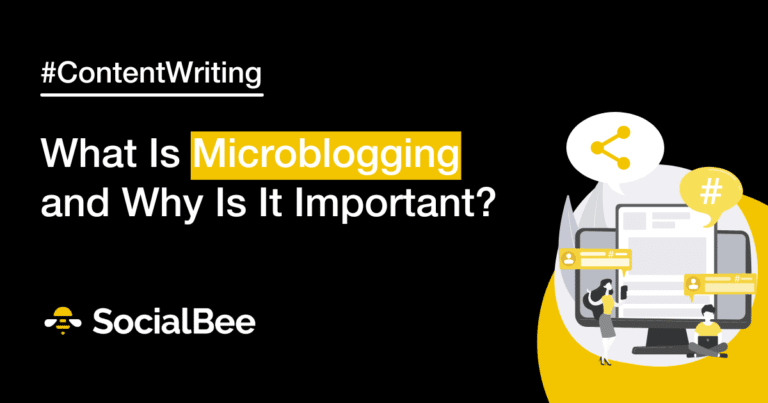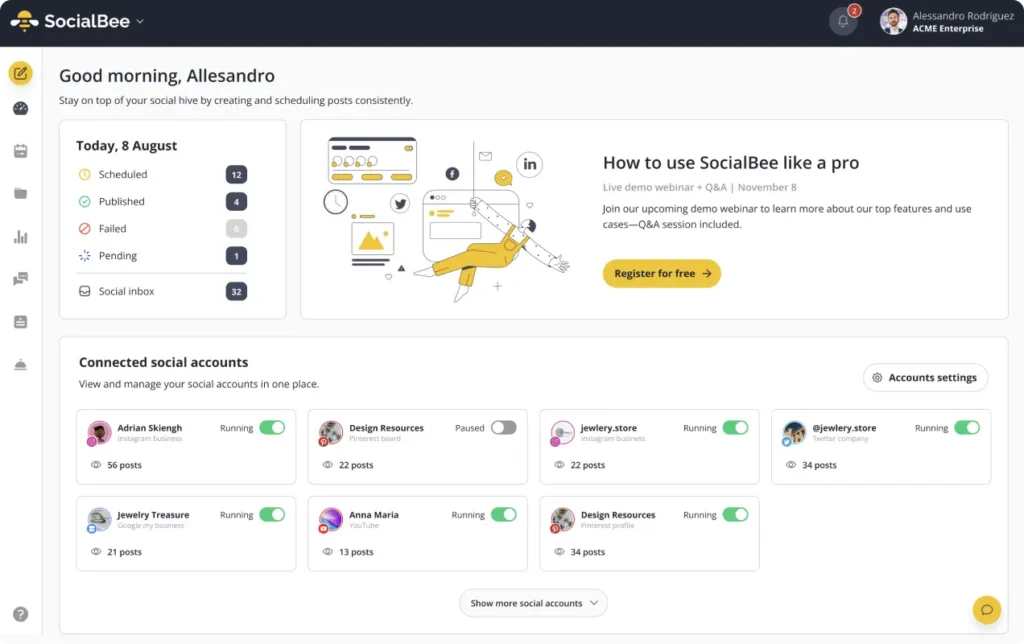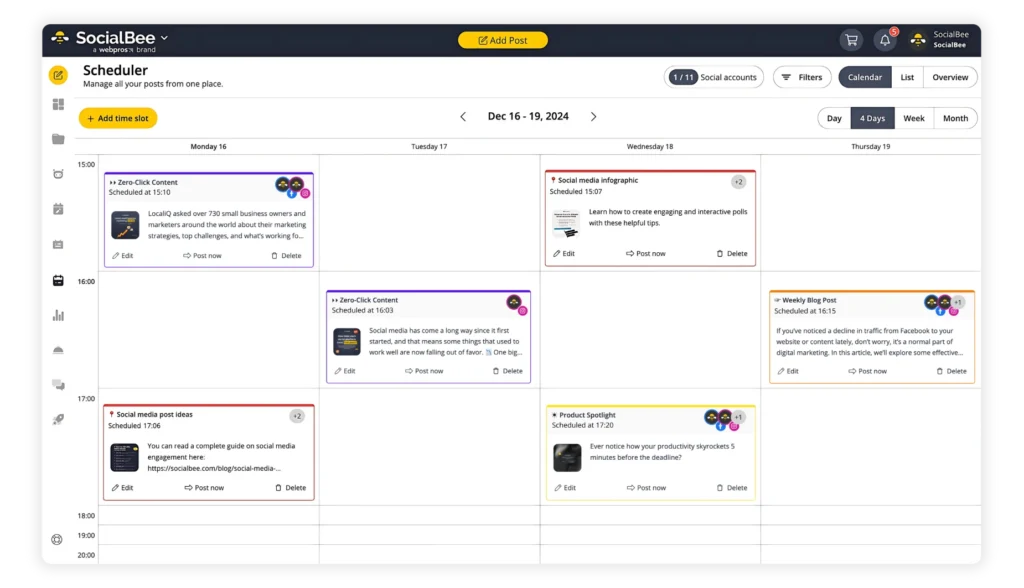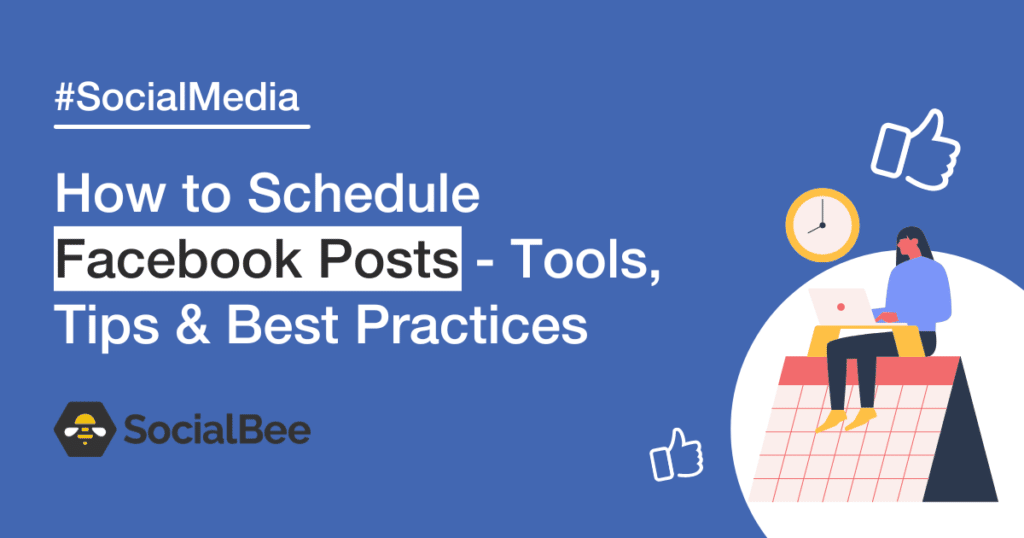
Content Writer
Welcome to the age of microblogging!
Every business that has a well-established marketing plan does it. After all, it’s one of the best ways to get traffic, improve search engine ranking, and show your expertise in a specific field. But what does a blog post need to have to be successful?
Well, quite a few things, but one of the most important elements in blogging is the blog’s length. The truth is, people just don’t have time to spare to go through a 2500+ word article anymore, which means that shorter, more concise blog posts have become a preferred option among customers and business people alike.
With this newfound preference for shorter forms of content, microblogging has become increasingly popular among internet users. But what exactly is microblogging and how can you integrate it into your business? Let’s find out!
Get the guide for creating a social media marketing plan for your business.

What Is Microblogging?
Microblogging is a specific type of blogging that offers content in a shorter format. This is a more manageable way of distributing content, as it offers bite-sized pieces of information. Many describe microblogging as a combination between normal blogging and instant messaging.
Microblogs, also called micro-posts, allow businesses, entrepreneurs, or anybody that is interested in microblogging to share content in the form of small sections of text, videos, or images.
When the term was first coined, there were websites that were created with the intent of microblogging, such as Twitter, Tumblr, and Plurk, but nowadays, most popular social media sites (Instagram, Facebook, LinkedIn, etc) have added microblogging sections to their platforms.
For example, on Facebook, you have a ‘What’s on your mind’ section, where you can essentially create a microblog post.
On Instagram, you can add images accompanied by bits of text relevant to the image posted. All of these posts can be relevant to your microblogging experience.
Without a doubt though, Twitter is the most popular microblogging platform, with 206 million monetizable daily active users worldwide.
So if your business is active on social media, chances are that you or your marketing team has created at least a few microblogs. These posts either contained a status update about your business (like when you’re going to restock a certain product), a promotional message, or a curated article.
Benefits of Microblogging
Before seeing how you can actively start posting microblogs, let’s see what are the benefits of these content formats.
The advantages of short posts on micro blogging sites are:
- Time efficiency
- Increase in the number of frequent posts
- Ease of sharing information
- Connection to your target audience
- Automation
1. Time Efficiency
Unsurprisingly, microblogs take much less time than normal blogs. Traditional blogging prosts can take up to eight hours to write, depending on the length of the post and the research that goes behind it.
But micro-posts are much easier to make. Generally, microblogs have under 300 words, so researching topics, creating images, and writing up microblogs should take an hour or less. Ideally, you could cut your research and writing time to half if you use an outline generator.
2. Increase in the Number of Frequent Posts
Due to the work involved in creating normal blog posts, this kind of content is released once a week or even once a month.
Because micro-posts can be created and distributed much faster, the microblogging frequency can be a lot higher. You can actually do it every day, and sometimes, multiple times a day, on different platforms.
If you’re active on social media and posting all kinds of content, then you can start with two microblogs per week and increase the number based on the response you get from your audience. You can also use AI to come up with ideas and content for posts.
This way, you can constantly stay in touch with your audience and make sure they don’t forget about you.
3. Ease of Sharing Information
Because this is a mix of blogging and instant messaging, your micro posts reach your audience in no time.
So if you have time-sensitive information or updates about your business, products, or services, then you can immediately share that information by creating a microblog.
Let’s say you have a flash sale going on and you want your customers to know about it. A great way to inform them is by creating a microblog with this information and a link to your website.
4. Connection to Your Target Audience
Traditional blogging can have comment sections and the blog posts can be shared by users, but with micro posting, staying connected is much more effortless.
As most microblogs generally go on social media, it is easier to see the reaction that your audience has to a certain post. Either through comments, number of shares and likes, or even through a direct message you might receive as feedback. You can gauge the reaction to microblogging much better and adapt future posts based on it.
5. Automatization
Did you know that, compared to traditional blogs, you can automate and schedule content on the most popular microblogging sites? This is probably one of the best reasons why you should start investing your time in microblogging. As mentioned, most social media platforms can be used for microblogging purposes.
With SocialBee, you can schedule and post your microblogs on different social media platforms at the same time.
So by using a tool such as SocialBee, you can start automating the posting process and have micro-posts coming on all of your social media accounts at regular intervals. That way, you can cover more ground and ensure that as many leads as possible see your posts.
By creating posts with SocialBee and using it to share the posts, you will save even more time and money.

Promote Your Microblogs with SocialBee!
How To Write Your First Microblog
Now that you know the key details about microblogging, let’s see how you can write your microblogs.
These are the steps you need to follow for successful microblogging:
- Select your microblogging platform
- Choose the type of content
- Use an automation tool
1. Select Your Microblogging Platform
Selecting the platform (or platforms) you want to share microblogs on is extremely important. The reason why is quite simple: Every single platform has very different requirements and practices.
You need to know what makes posts successful on each social media platform in part and customize your microblog posts to fit those social media standards.
Here are some fundamental things you should know about every microblogging site:
A. Instagram
- Instagram mostly focuses on the visual content
- The largest demographic using Instagram is people between the ages of 18 and 34 years
- The character limit is 2,200 characters
- Hashtags are extremely important — the maximum number of hashtags is 30, but the best practice is to select 11 high-focused hashtags
- The best times to post on Instagram are on Tuesdays, Wednesdays, and Fridays in the morning (6 AM – 9 AM), at midday (12 PM – 2 PM), and in the evening (5 PM – 6 PM)
B. Facebook
- Facebook is considered one of the most popular social media platforms of all time
- The largest demographic using Facebook is male users between the ages of 25 and 34 years
- The character limit is 63,206 characters
- Although hashtags are not common on Facebook, they can be used when absolutely necessary — one or two is the standard
- The overall best times to post Facebook content are Monday through Friday in the mornings from 9 AM to 10 AM and in the early afternoons around 1 PM to 4 PM
C. Twitter
Here is what you need to know about posting microblogs on Twitter:
- Twitter is a social media platform mostly known for its fast-paced distribution of information
- The largest demographic of Twitter users is between 25 and 34 years old
- The character limit is 280 characters
- Hashtags have significant importance on Twitter — the best practice is to use two hashtags that you integrate into the body of the microblog
- The best times to post on Twitter tend to be during the workweek, Monday through Friday during morning to early afternoon hours, specifically from 9 AM to 3 PM
D. LinkedIn
These are some aspects to keep in mind if you choose to post your microblogs on LinkedIn:
- LinkedIn is a professional networking site to connect with other businesses or professionals in your field and for B2B marketing
- The largest demographic using LinkedIn is professionals between 25 and 34 years old
- The character limit is 3000 characters
- Just like on the majority of social media platforms, you can use hashtags on LinkedIn — you should use between two and six hashtags
- The best times to post on LinkedIn are Tuesdays, Wednesdays, and Thursdays, within business hours, particularly from 9 AM to 5 PM
2. Choose the Type of Content
You can post any kind of content in your microblogs. Sure, you can make your content promotional, but you can also design content that informs and entertains your followers.
Here are a few examples that could work for you in terms of content marketing:
- Status updates — you can share news regarding a new project that you’re working on, a sale, the launch of a new service, etc.
- Memes — you can create memes that are specific to your field in order to amuze your audience
- Quotes — you can share quotes that inspired you to become better or that can inspire your audience
- Infographics — educational content with the purpose of giving additional context or information to your audience; they can be highly useful if you choose to microblog on a more visual platform
- Videos — these videos can complete a copy that you’re sharing or they can be standalone
- Links — these links can be to pointing out to a blog post that you just wrote, other useful articles that you have found, breaking news updates in the field, or even your products or services
Ideally, it would be great if you can experiment with different kinds of microblogs and see which ones work better for your specific audience. Just post your microblogs and keep an eye on how your audience interacts with each post in part.
3. Use an Automation Tool
Most microblogging happens on social media platforms, so using a social media automation tool would be ideal for your business.
SocialBee is one of the best and most affordable options on the market when it comes to distributing content online.
With SocialBee, you can create, edit, schedule and organize your microblogs in categories.
How to use SocialBee for microblogging:
- Create a Content Category for “Microblogs” in SocialBee.
- Add it to your weekly posting schedule twice.
- Create new microblogs for all social profiles.
But SocialBee is suitable for way more than microblogging. It has a plethora of features that can help you with your social media management at all times.
Here’s what you can do with SocialBee:
- Create content and customize it for each platform in part
- Build different content categories
- Edit multiple posts at the same time with the bulk editor
- Create hashtag collections
- Post at specific times by creating a posting schedule for each profile and category in part
- Import multiple media files and links at the same time
- Get audience statuses and reports regarding your top-performing posts
These are just a few of the things you can do with SocialBee. But the best thing is that you can try SocialBee for free during the 14-day trial.
You can create your first microblogs and share them on all your microblogging sites. That way, you can try this amazing social media tool and try out microblogging, effectively hitting two birds with one stone.
Microblogging FAQ
Do you still have some questions about microblogging? Here are some answers to frequently asked questions that might help you develop your understanding of the topic.
1. What Are the Most Popular Microblogging Platforms?
Twitter and Reddit are the most used platforms for microblogging.
2. What Is the Difference Between Microblog Posts and Traditional Blogs?
The main difference between microblog posts and traditional blogs is the content length.
Microblogs are shorter than traditional blogs, and they contain only a few sentences. On the other hand, traditional blogs are lengthy forms of content (typically longer than 800 words) with more detailed information and topic analysis.
3. What Are Some Examples of Microblogging?
Here are five examples of microblogging ideas:
- Post pictures from your daily life
- Express your opinion on an article you read recently
- Talk about news and current events
- Offer advice on how to do/achieve something
- Ask questions and solicit opinions from followers
4. Is Twitter a Microblogging Platform?
Yes, Twitter is a popular microblogging platform. It’s primarily known for its short content format and users typically utilize the platform to share concise posts of around 280 characters or less.
5. What Are the 5 Types of Microblogging?
The five types of microblogging are:
- Status updates: Status updates are short messages that allow people to share their thoughts, opinions, and experiences with their followers.
- Photo and video sharing: Photos and videos are great for sharing moments from your life. You can also use visual media to convey a message.
- Polls and surveys: Polls and surveys are great for gathering opinions on topics or products from an audience quickly.
- Hashtag campaigns: Hashtags help users associate their posts with specific topics in order to gain more visibility for targeted searches.
- Live streaming: Live streaming is a practice that helps creators engage with their audience in real time. It allows users to broadcast concerts, and conferences, run Q&As and have direct conversations with the help of online platforms.
Ready to Use Microblogging Platforms?
If you want your marketing strategy to work, you need to make use of both blogging and microblogging. Normal blog posts will show your expertise in your business’s field and microblogging will keep you connected to your audience.
But sometimes, creating content does not come easily. And when you have no inspiration to write or design content, you tend to put it aside for later. Hours can become days, and days can become weeks with no blogs or microblogs. This can be avoided by having somebody create content for you. ConciergeBee’s services give you the opportunity to work with talented marketers who will make the content your business needs.
If you prefer to create your own content, worry not. You can still use SocialBee to schedule and edit your content! Start your 14-day free trial now!
















